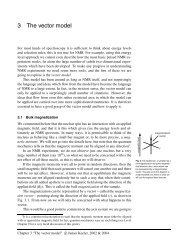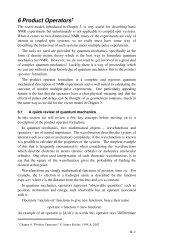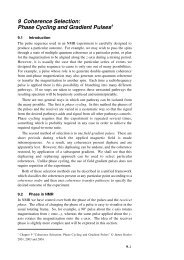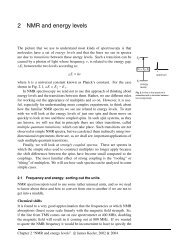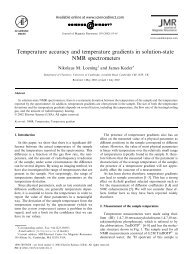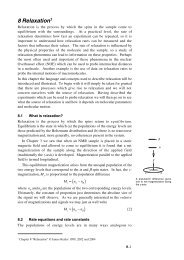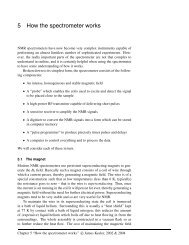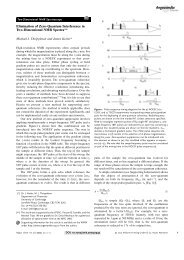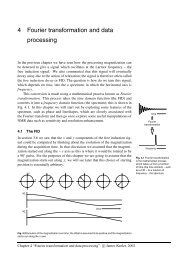PDF of the lecture slides - The James Keeler Group
PDF of the lecture slides - The James Keeler Group
PDF of the lecture slides - The James Keeler Group
You also want an ePaper? Increase the reach of your titles
YUMPU automatically turns print PDFs into web optimized ePapers that Google loves.
EUROMAR 2011<br />
Coherence order and<br />
coherence selection<br />
<strong>James</strong> <strong>Keeler</strong><br />
Department <strong>of</strong> Chemistry<br />
Why we need coherence selection<br />
DQF COSY<br />
DQ spectrum<br />
NOESY<br />
<strong>The</strong> spins don’t know what we want !<br />
We want one out <strong>of</strong> many possibilities<br />
Outline<br />
• Why we need coherence selection<br />
• Concept <strong>of</strong> coherence order<br />
• Coherence transfer pathways (CTPs)<br />
• Selecting a CTP with phase cycling<br />
• Selecting a CTP with gradients<br />
• Suppression <strong>of</strong> zero-quantum<br />
coherence<br />
ρˆ<br />
( p)<br />
Coherence order, p<br />
Defined by phase acquired during<br />
rotation by about z<br />
rotate by φ about z<br />
⎯⎯⎯⎯⎯→ρˆ<br />
( p)<br />
phase acquired is −pφ<br />
× exp( −ipφ)<br />
different p separated by using this property<br />
Fur<strong>the</strong>r information<br />
• <strong>PDF</strong> <strong>of</strong> <strong>the</strong>se <strong>slides</strong> available at<br />
http://www-keeler.ch.cam.ac.uk/<br />
• See also:<br />
Understanding NMR Spectroscopy,<br />
<strong>James</strong> <strong>Keeler</strong> (Wiley) [Chapt. 11]<br />
Spin Dynamics. Basics <strong>of</strong> Nuclear<br />
Magnetic Resonance, Malcolm Levitt<br />
(Wiley)<br />
Properties <strong>of</strong> coherence order<br />
• takes values 0, ±1, ±2 …<br />
0 is z-magnetization,<br />
±1 is single quantum,<br />
±2 is double quantum etc.<br />
• only p = −1 is observable<br />
• maximum/minimum value is ±N, where<br />
N is number <strong>of</strong> spins<br />
1
p<br />
Effect <strong>of</strong> pulses<br />
RF pulse<br />
all possible<br />
values <strong>of</strong> p<br />
- which is why we need selection<br />
special case:<br />
p<br />
180° pulse<br />
−p<br />
Frequency discrimination<br />
and lineshapes in 2D<br />
for absorption mode spectra must retain<br />
p = ± 1 during t1 : symmetrical pathways<br />
combine this with frequency discrimination<br />
using ‘TPPI’ or ‘States’<br />
Coherence transfer pathway (CTP)<br />
Indicates <strong>the</strong> desired coherence order<br />
at each point<br />
DQF COSY DQ spect. NOESY<br />
note: always starts at p = 0<br />
always ends at p = −1<br />
- or, alternatively<br />
N-type<br />
P-type<br />
1. record two separate spectra:<br />
echo or N-type: p = + 1 during t 1<br />
anti-echo or P-type: p = − 1 during t 1<br />
2. combine to give absorption spectrum<br />
Heteronuclear experiments<br />
HMQC<br />
separate p for each nucleus (p I , p S )<br />
ends with p = −1 on observed nucleus<br />
pulse to S only affects p S<br />
Phase cycling<br />
2
Pulse phase<br />
<strong>the</strong> phase <strong>of</strong> <strong>the</strong> spectrum depends on<br />
<strong>the</strong> phase <strong>of</strong> <strong>the</strong> pulse<br />
Phase cycling<br />
Selection <strong>of</strong> a pathway by repeating <strong>the</strong><br />
sequence with a systematic variation<br />
<strong>of</strong> <strong>the</strong> pulse and rx. phases<br />
How to design <strong>the</strong> sequence <strong>of</strong> phases,<br />
-<strong>the</strong> phase cycle?<br />
fixed rx.<br />
phase<br />
rx. phase<br />
follows<br />
pulse phase<br />
Receiver (rx.) phase<br />
Effect <strong>of</strong> phase shift <strong>of</strong> pulse<br />
rx. phase<br />
Pulse causes transfer from p1 to p2 Change in coherence order Δp = p2 – p1 If pulse phase shifted by Δφ phase<br />
acquired by signal is<br />
−Δp × Δφ<br />
Receiver phase<br />
If <strong>the</strong> signal generated by <strong>the</strong> pulse<br />
sequence shifts in phase, <strong>the</strong>n this can<br />
always be compensated for by shifting<br />
<strong>the</strong> receiver by <strong>the</strong> same amount.<br />
Selection <strong>of</strong> a single pathway<br />
+2 to −1, so Δp = –1 – (+2) = – 3<br />
phase acquired by signal when pulse<br />
shifted by Δφ is<br />
− Δp × Δφ = 3 Δφ<br />
3
step<br />
1<br />
2<br />
3<br />
4<br />
Four-step cycle<br />
pulse Δφ<br />
0°<br />
90°<br />
180°<br />
270°<br />
3 Δφ<br />
Four-step cycle<br />
Pulse goes<br />
[0°, 90°, 180°, 270°]<br />
equiv(3 Δφ)<br />
Pathway with Δp = −3 acquires phase<br />
[0°, 270°, 180°, 90°]<br />
If receiver phase follows <strong>the</strong>se phases,<br />
contribution from <strong>the</strong> pathway will add up<br />
- but what about o<strong>the</strong>r pathways?<br />
step<br />
1<br />
2<br />
3<br />
4<br />
Four-step cycle<br />
pulse Δφ<br />
0°<br />
90°<br />
180°<br />
270°<br />
3 Δφ<br />
0°<br />
270°<br />
540°<br />
810°<br />
- o<strong>the</strong>r pathways<br />
equiv(3 Δφ)<br />
e.g. Δp = – 2 so − Δp × Δφ = 2 Δφ<br />
step<br />
1<br />
2<br />
3<br />
4<br />
pulse Δφ<br />
0°<br />
90°<br />
180°<br />
270°<br />
2 Δφ<br />
0°<br />
180°<br />
360°<br />
540°<br />
Selected with rx. phases<br />
[0°, 270°, 180°, 90°] ?<br />
equiv(2 Δφ)<br />
0°<br />
180°<br />
0°<br />
180°<br />
step<br />
1<br />
2<br />
3<br />
4<br />
Δp= –3<br />
Four-step cycle<br />
pulse Δφ<br />
0°<br />
90°<br />
180°<br />
270°<br />
3 Δφ<br />
0°<br />
270°<br />
540°<br />
810°<br />
Selected pathways<br />
equiv(3 Δφ)<br />
0°<br />
270°<br />
180°<br />
90°<br />
rx. phase [0°, 270°, 180°, 90°]<br />
rx. phase coherence<br />
phase<br />
For Δp= –3, rx. phase follows coherence<br />
phase:<br />
all four steps add up<br />
4
Δp= –2<br />
Selected pathways<br />
rx. phase [0°, 270°, 180°, 90°]<br />
rx. phase coherence<br />
phase<br />
For Δp= –2, signal cancels on four steps<br />
Combining phase cycles<br />
four-step cycle to select Δp = −2<br />
step<br />
1<br />
2<br />
3<br />
4<br />
pulse Δφ2 0°<br />
90°<br />
180°<br />
270°<br />
2 Δφ2 0°<br />
180°<br />
360°<br />
540°<br />
equiv(− Δφ2 )<br />
0°<br />
180°<br />
0°<br />
180°<br />
Selectivity<br />
A four-step cycle designed to select<br />
a particular value <strong>of</strong> Δp will also select<br />
Δp + 4, Δp + 8 … and Δp − 4, Δp − 8…<br />
- all o<strong>the</strong>r pathways are suppressed<br />
(−4) −3 (−2) (−1) (0) 1 (2) (3) (4) 5<br />
selected in bold, suppressed in ()<br />
Complete both cycles independently<br />
step<br />
1<br />
2<br />
3<br />
4<br />
5<br />
6<br />
7<br />
8<br />
9<br />
10<br />
11<br />
12<br />
13<br />
14<br />
15<br />
16<br />
Δφ 1<br />
0°<br />
90°<br />
180°<br />
270°<br />
0°<br />
90°<br />
180°<br />
270°<br />
0°<br />
90°<br />
180°<br />
270°<br />
0°<br />
90°<br />
180°<br />
270°<br />
−Δφ 1<br />
0°<br />
−90°<br />
−180°<br />
−270°<br />
0°<br />
−90°<br />
−180°<br />
−270°<br />
0°<br />
−90°<br />
−180°<br />
−270°<br />
0°<br />
−90°<br />
−180°<br />
−270°<br />
equiv(−Δφ 1 )<br />
0°<br />
270°<br />
180°<br />
90°<br />
0°<br />
270°<br />
180°<br />
90°<br />
0°<br />
270°<br />
180°<br />
90°<br />
0°<br />
270°<br />
180°<br />
90°<br />
Δφ 2<br />
0°<br />
0°<br />
0°<br />
0°<br />
90°<br />
90°<br />
90°<br />
90°<br />
180°<br />
180°<br />
180°<br />
180°<br />
270°<br />
270°<br />
270°<br />
270°<br />
2 Δφ 2<br />
0°<br />
0°<br />
0°<br />
0°<br />
180°<br />
180°<br />
180°<br />
180°<br />
360°<br />
360°<br />
360°<br />
360°<br />
540°<br />
540°<br />
540°<br />
540°<br />
equiv(2Δφ 2 )<br />
0°<br />
0°<br />
0°<br />
0°<br />
180°<br />
180°<br />
180°<br />
180°<br />
0°<br />
0°<br />
0°<br />
0°<br />
180°<br />
180°<br />
180°<br />
180°<br />
total<br />
0°<br />
270°<br />
180°<br />
90°<br />
180°<br />
90°<br />
0°<br />
270°<br />
0°<br />
270°<br />
180°<br />
90°<br />
180°<br />
90°<br />
0°<br />
270°<br />
Combining phase cycles<br />
four-step cycle to select Δp = +1<br />
step<br />
1<br />
2<br />
3<br />
4<br />
pulse Δφ1 0°<br />
90°<br />
180°<br />
270°<br />
−Δφ 1<br />
0°<br />
−90°<br />
−180°<br />
−270°<br />
Tricks: 1<br />
equiv(− Δφ1 )<br />
0°<br />
270°<br />
180°<br />
90°<br />
1. <strong>The</strong> first pulse can only generate<br />
p = ±1 from equilibrium magnetization<br />
- no need to phase cycle this pulse<br />
5
Tricks: 2<br />
2. <strong>Group</strong> pulses toge<strong>the</strong>r and cycle as<br />
a unit<br />
All pulses: [0°, 90°, 180°, 270°]<br />
Rx. for Δp = ±2: [0°, 180°, 0°, 180°]<br />
Refocusing pulses: EXORCYCLE<br />
Refocusing pulses cause p →−p e.g. Δp = ±2<br />
(single quantum)<br />
Pulse: [0°, 90°, 180°, 270°]<br />
Rx. for Δp = ±2: [0°, 180°, 0°, 180°]<br />
Tricks: 3<br />
3. Only p = −1 is observable,<br />
so it does not matter if o<strong>the</strong>r values <strong>of</strong><br />
p are generated by <strong>the</strong> last pulse<br />
- no need to phase cycle <strong>the</strong> last pulse,<br />
if a coherence order has been selected<br />
unambiguously before this pulse<br />
Axial peak suppression<br />
z-magnetization which recovers by<br />
relaxation during a pulse sequence is<br />
made observable by last pulse<br />
- leads to peaks at ω 1 =0: axial peaks<br />
- easily suppressed using a two-step cycle<br />
1 st pulse: [0°, 180°]<br />
Rx. for Δp = ±1: [0°, 180°]<br />
Tricks: 4<br />
4. Don’t worry about high orders <strong>of</strong><br />
multiple quantum coherence<br />
e.g ≥ 4.<br />
- <strong>the</strong>y are hard to generate and likely<br />
to give weak signals, especially if<br />
<strong>the</strong> lines are broad<br />
Examples: DQF COSY<br />
symmetrical<br />
pathways in t 1<br />
final pulse has Δp = −3 and +1<br />
- select using four-step cycle:<br />
φ3 = [0°, 90°, 180°, 270°]<br />
φrx = [0°, 270°, 180°, 90°]<br />
this is sufficient, as p can only be ±1 in t1 6
DQF COSY (alternative)<br />
group first two pulses and select Δp = ±2<br />
- select using four-step cycle:<br />
φ1 and φ2 = [0°, 90°, 180°, 270°]<br />
= [0°, 180°, 0°, 180°]<br />
φ rx<br />
symmetrical<br />
pathways in t 1<br />
this is sufficient, as p can only be −1 in t 2<br />
Problems with phase cycling<br />
• phase cycle must be completed:<br />
- unacceptably long experiment,<br />
especially for 2D/3D<br />
• cancellation <strong>of</strong> unwanted signals may<br />
be imperfect (especially for proton<br />
detected experiments)<br />
Examples: NOESY<br />
final pulse has Δp = −1<br />
- select using four-step cycle:<br />
φ 3 = [0°, 90°, 180°, 270°]<br />
φ rx = [0 °, 90°, 180°, 270°]<br />
symmetrical<br />
pathways in t 1<br />
this is sufficient, as p can only be ±1 in t 1<br />
Gradient pulses<br />
Step<br />
Φ 1<br />
Φ 3<br />
Φ rx<br />
Examples: NOESY<br />
axial peak suppression also required<br />
φ 1 = [0°, 180°] φ rx = [0°, 180°]<br />
1<br />
0°<br />
0°<br />
0°<br />
2<br />
0°<br />
90°<br />
90°<br />
3<br />
0°<br />
180°<br />
180°<br />
0°<br />
270°<br />
270°<br />
180°<br />
0°<br />
180°<br />
180°<br />
90°<br />
270°<br />
Field gradient pulses<br />
4<br />
5<br />
6<br />
7<br />
180°<br />
180°<br />
•<strong>the</strong> B 0 field is made inhomogeneous<br />
for a short period (few ms)<br />
• coherences dephase, all signal lost<br />
• a subsequent gradient may rephase<br />
some <strong>of</strong> <strong>the</strong> coherences<br />
0°<br />
8<br />
180°<br />
270°<br />
90°<br />
7
Effect <strong>of</strong> a gradient<br />
<strong>of</strong>f: sharp line<br />
gradient<br />
active volume<br />
on: v. broad line<br />
Selection with a gradient pair<br />
phase due to G 1 : φ 1 (z) = −p 1 × γ G 1 z τ 1<br />
phase due to G 2 : φ 2 (z) = −p 2 × γ G 2 z τ 2<br />
refocusing condition: φ 1 (z)+ φ 2 (z) = 0<br />
Dephasing and rephasing<br />
dephase<br />
rephase<br />
Selection with a gradient pair<br />
φ 1 (z) + φ 2 (z) = −p 1 γ G 1 z τ 1 − p 2 γ G 2 z τ 2<br />
= 0<br />
G1τ<br />
1 p2<br />
= −<br />
G τ p<br />
2<br />
2<br />
1<br />
Spatially dependent phase<br />
phase acquired by coherence p at<br />
position z in sample, after time t<br />
φ(z) = −p × γ G z t<br />
gyromagnetic ratio<br />
gradient strength, G cm −1<br />
phase depends on position and p<br />
Selection with a gradient pair<br />
e.g. p 1 = +2, p 2 = −1<br />
alternatives<br />
G τ<br />
G τ<br />
1 1<br />
if G 1 = G 2 , τ 2 = 2 τ 1<br />
2<br />
2<br />
p<br />
= −<br />
p<br />
G1<br />
τ1<br />
−1<br />
= − =<br />
G τ + 2<br />
if τ 1 = τ 2 , G 2 = 2 G 1<br />
2<br />
2<br />
2<br />
1<br />
1<br />
2<br />
8
Selection with a gradient pair<br />
e.g. p 1 = −2, p 2 = −1<br />
G τ<br />
G τ<br />
1 1<br />
2<br />
2<br />
p<br />
= −<br />
p<br />
G1τ1<br />
−1<br />
1<br />
= − = −<br />
G τ − 2 2<br />
refocusing: τ 1 = τ 2 , G 2 = −2 G 1<br />
‘−G’ means opposite sense <strong>of</strong> gradient<br />
Refocusing pulses<br />
Ideal 180° causes p → −p<br />
Selected for all p by equal gradients<br />
- ‘cleans up’ imperfect 180°<br />
2<br />
2<br />
2<br />
1<br />
Heteronuclear case<br />
φ 1 (z) = −(p I γ I +p S γ S )G 1 zτ 1 = −(−γ I +γ S )G 1 zτ 1<br />
G τ<br />
G τ<br />
1 1<br />
2<br />
2<br />
=<br />
1<br />
( γ γ ) −1<br />
S<br />
I<br />
only p S<br />
changes<br />
φ 2 (z) = −(p I g I +p S γ S )G 2 zτ 2 = −(−γ I −0)G 2 zτ 2<br />
180° in heteronuclear case<br />
no coherence<br />
on I spin<br />
180° to I is acting as inversion pulse<br />
Gradient pair ‘cleans up’ imperfect 180°<br />
- leaves S spin coherences unaffected<br />
Only one pathway selected<br />
G τ<br />
G τ<br />
1 1 =<br />
G1τ1<br />
1<br />
= −<br />
G2τ<br />
2 2<br />
can only select one <strong>of</strong> <strong>the</strong>se pathways<br />
- potential loss <strong>of</strong> sensitivity<br />
- problems in two-dimensional NMR<br />
Phase errors<br />
2<br />
2<br />
1<br />
2<br />
DQF COSY<br />
Offsets continue to evolve during gradients<br />
- results in severe frequency-dependent<br />
phase errors<br />
9
Avoiding phase errors<br />
add refocusing pulse / use an existing one<br />
<strong>of</strong>fset evolution<br />
refocused<br />
by 180° pulse<br />
Examples: HMQC<br />
I<br />
S<br />
more time<br />
efficient alternative<br />
• separate expts. for P- and N-type<br />
• additional 180° associated with both G 1<br />
• G 2 in existing delay, so no phase error<br />
Selection <strong>of</strong> z-magnetization<br />
A gradient dephases all* coherences:<br />
- leaves behind only z-magnetization<br />
- simple and convenient<br />
called a purge gradient or homospoil<br />
*except homonuclear zero-quantum<br />
HMQC: refocusing condition<br />
I<br />
S<br />
( − γ zτ<br />
− γ G zτ<br />
) + ( γ G zτ<br />
P-type<br />
(solid line)<br />
− γ G zτ<br />
) + ( γ G zτ<br />
) = 0<br />
IG1<br />
1 S 1 1 I 1 1 S 1 1 I<br />
− τ = 0<br />
2γSG1 zτ1<br />
+ γIG2<br />
z 2<br />
G1<br />
τ1<br />
γI<br />
=<br />
G τ 2γ<br />
2 2<br />
S<br />
2<br />
2<br />
Examples: DQF COSY<br />
• symmetrical pathways in t 1 (no gradient)<br />
• extra 180° pulses to avoid phase errors<br />
• loss <strong>of</strong> sensitivity<br />
HMQC: suppression <strong>of</strong> I spin<br />
magnetization not coupled to S<br />
I<br />
S<br />
• I magnetization dephased by 1 st G 1 ,<br />
but rephased by second G 1 , and <strong>the</strong>n<br />
dephased by G 2<br />
10
HSQC<br />
• G 1 is purge gradient<br />
• extra 180° associated with G 2<br />
• G 3 in existing spin echo<br />
•can omit G 2 and G 3 (labelled samples)<br />
An old, old problem in NMR<br />
z-magnetisation and zero-quantum<br />
coherence cannot be separated using<br />
phase cycling or gradients<br />
because<br />
nei<strong>the</strong>r respond to z-rotations<br />
i.e. both have coherence order, p,<br />
<strong>of</strong> zero<br />
Advantages and disadvantages<br />
+ minimizes experiment time<br />
+ excellent suppression, especially in<br />
heteronuclear experiments with 1 H obs.<br />
- cannot select more than one pathway<br />
→ possible loss <strong>of</strong> SNR<br />
→ obtaining pure phase more complex<br />
- phase errors<br />
→ requires elaboration <strong>of</strong> sequence<br />
- loss due to diffusion<br />
Why is it a problem?<br />
a 90° pulse converts z-magnetization<br />
into in-phase magnetization along y<br />
but converts ZQ into anti-phase<br />
along x<br />
<strong>the</strong> result is phase distortion and<br />
unwanted peaks<br />
Zero-quantum dephasing<br />
Result: distorted multiplets in 2D<br />
z-magn. + ZQ z-magn. only<br />
11
RF<br />
G<br />
Example: NOESY<br />
t 1 m<br />
wanted: z-magn. during m<br />
→ in-phase, absorption multiplets<br />
unwanted: ZQ during m<br />
→ anti-phase, dispersion multiplets<br />
‘J-peaks’<br />
Zero-quantum evolution<br />
RF<br />
G<br />
<strong>The</strong> zero quantum evolves during<br />
τ z at (Ω 1 −Ω 2 ), <strong>the</strong> difference <strong>of</strong><br />
<strong>the</strong> shifts<br />
Macura et al 1981<br />
90° 90°<br />
z<br />
t 2<br />
this is <strong>the</strong> key …<br />
RF<br />
G<br />
I 1x<br />
<strong>The</strong> z-filter<br />
Sørensen, Rance, Ernst 1984<br />
90°(y)<br />
−I 1z<br />
90°(−y)<br />
I 1x<br />
everything else dephased<br />
only in-phase magnetization survives<br />
Make evolution dependent on<br />
position<br />
180<br />
z<br />
frequency time<br />
position<br />
2I 1y I 2z<br />
RF<br />
G<br />
but …<br />
90°(y)<br />
2I 1y I 2x<br />
½(2I 1y I 2x −2I 1x I 2y )<br />
90°(−y)<br />
mixture <strong>of</strong><br />
DQ and ZQ<br />
½(2I 1y I 2z −2I 1z I 2y )<br />
ZQ<br />
Anti-phase component passes through<br />
Zero-quantum dephasing<br />
As frequency is a function <strong>of</strong> position,<br />
<strong>the</strong> zero-quantum coherence will<br />
dephase<br />
Identical to dephasing in a conventional<br />
gradient<br />
how to make 180° position dependent?<br />
12
Swept-frequency 180º<br />
normal spectrum<br />
apply gradient<br />
frequency position<br />
swept-frequency 180º pulse<br />
different parts experience pulse at different times<br />
RF<br />
G<br />
NOESY with zero-quantum<br />
suppression<br />
t 1<br />
τ m<br />
swept 180º with gradient<br />
additional dephasing gradient<br />
NOE continues to build up throughout<br />
z-filter with zero-quantum<br />
suppression<br />
RF<br />
G<br />
swept 180º with gradient<br />
additional dephasing gradient<br />
(to make sure everything is dephased)<br />
NOESY results (strychnine)<br />
conventional + ZQ suppression<br />
Typical parameters<br />
• swept pulse <strong>of</strong> duration 15 to 30 ms<br />
• gradient 1 to 2 G cm −1<br />
• dephasing rate depends on ZQ frequency<br />
• suppression <strong>of</strong> ZQ by factor <strong>of</strong> 100<br />
RF<br />
G<br />
t 1<br />
TOCSY<br />
DIPSI-2<br />
isotropic mixing within z-filter<br />
ZQ dephasing needed before and<br />
after mixing; unequal durations<br />
t 2<br />
13
TOCSY results (strychnine)<br />
conventional + ZQ suppression<br />
<strong>The</strong> End<br />
Phew!<br />
TOCSY results (strychnine)<br />
step<br />
φ S<br />
φ I<br />
φ rx<br />
conventional + ZQ suppress.<br />
Examples: HMQC<br />
select Δp S = ±1 at first S pulse<br />
and Δp I = ±2 at 180° I pulse<br />
1<br />
0°<br />
0°<br />
0°<br />
2<br />
180°<br />
0°<br />
180°<br />
3<br />
0°<br />
90°<br />
180°<br />
4<br />
180°<br />
90°<br />
0°<br />
5<br />
0°<br />
180°<br />
0°<br />
6<br />
180°<br />
180°<br />
180°<br />
7<br />
0°<br />
270°<br />
180°<br />
8<br />
180°<br />
270°<br />
0°<br />
Advantages <strong>of</strong> <strong>the</strong> z-filter<br />
• excellent suppression<br />
• no increase in experiment time<br />
• simple to implement<br />
• widely applicable<br />
• negligible reduction in signal<br />
Difference spectroscopy: HMQC<br />
<strong>The</strong> cycle [0°, 180°] on first S pulse and<br />
rx. is just difference spectroscopy:<br />
selects that part <strong>of</strong> <strong>the</strong> signal which<br />
goes via <strong>the</strong> S spin<br />
14
Difference spectroscopy<br />
In heteronuclear experiments, a simple<br />
two-step phase cycle (+x/−x) on <strong>the</strong><br />
pulse causing <strong>the</strong> transfer <strong>of</strong>ten suffices<br />
- this is simply difference spectroscopy<br />
15



